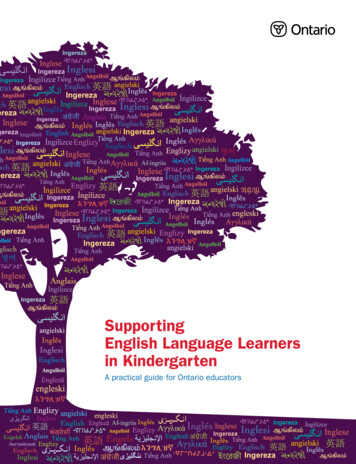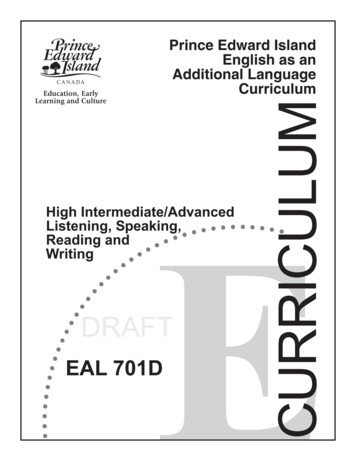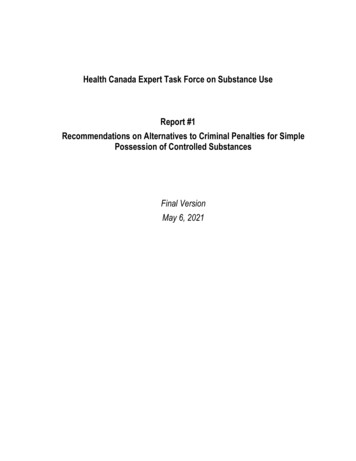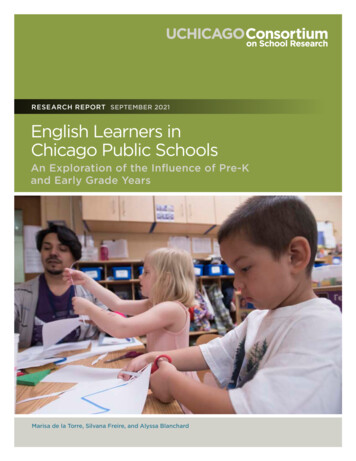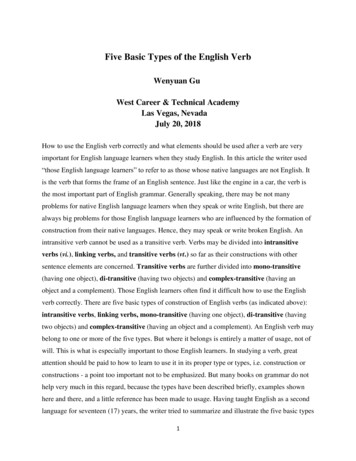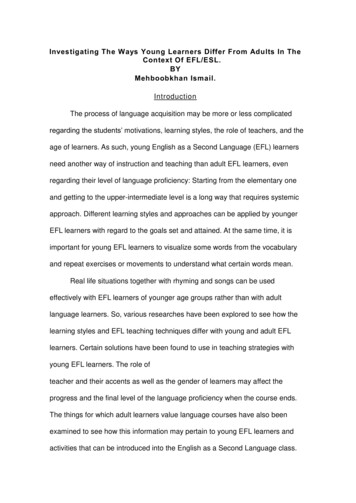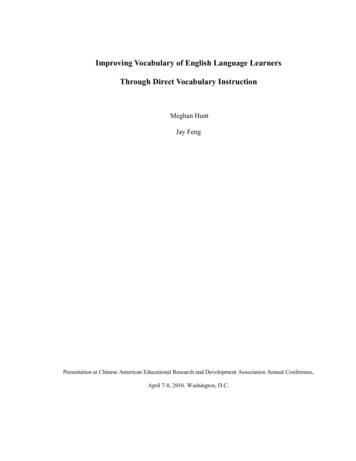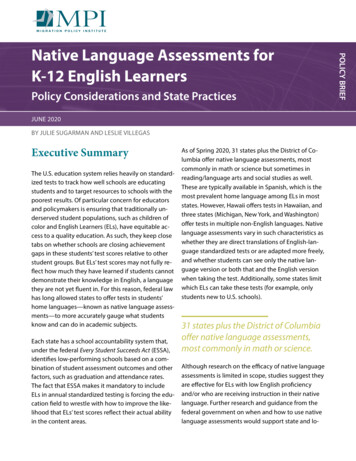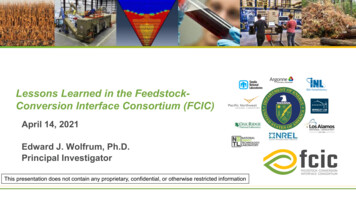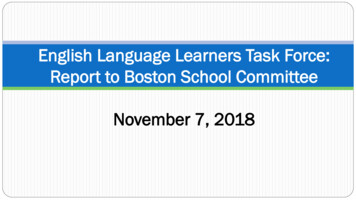
Transcription
English Language Learners Task Force:Report to Boston School CommitteeNovember 7, 2018
ELLTF BackgroundThe English Language Learners (ELL) Task Force of the Boston SchoolCommittee was created in October 2009 for the following purposes: Provide guidance to the School Committee and the Superintendentregarding a vision and a plan of action to respond appropriately to thegrowth in the numbers of students whose first language is a language otherthan English. Identify mechanisms to address the needs of ELLs. Monitor the district’s progress in meeting the educational needs of ELLs.2
ELLs in BPSAt least forty-nine 49% of BPS students havea first language that is not English. 31% of BPS students areidentified as Englishlearners (17,442 ELLs). 74 first languages arespoken by BPS ELLs.Source: BPS. Data includes active BPS K0-12 students as of April 17, 2018, Aspen SIS (includes in-district Horace Mann charter schools; excludes student outplacements).
ELL-SWDs in BPSThere is substantial overlap between ELLsand students with disabilities (SWDs).One-third (34%) of all students withdisabilities are English learners (3,802 students).One-fifth (22%) of all English learners arestudents with disabilities (3,802 students).Source: BPS. Data includes active BPS K0-12 students as of April 17, 2018, Aspen SIS (includes in-district Horace Mann charter schools; excludes student outplacements).
ELLTF Goals1. Recognize and promote BPS as a multilingual, multicultural district2. Promote and monitor progress in distributing responsibility foroutcomes of ELL students to all parts of the BPS organization3. Continue to monitor, assess, and advocate to improve: School district data systems and the use of technology Impacts of student assessment and assignment policies on ELLs ELL program quality Engagement of families of ELLs and linguistic minority communities Services to and outcomes for ELL students with disabilities (ELLSWD)5 Human capital alignment with ELL needs
ELLTF Composition / Organization 18 volunteer members (see Appendix 1) Bi-monthly meetings Subcommittees that work in target areas Data (SY17-18: Janet Anderson and MirenUriarte; SY18-19: TBD) Program Quality (SY17-18: Diana Lam;SY18-19: Suzanne Lee) English Learner Students withDisabilities (ELSWD) (Maria de LourdesSerpa and John Mudd) Parent Engagement (Rev. Cheng Imm Tan) Human Capital (Suzanne Lee and John Mudd)6The ELLTF and its subcommittees. . . Interact with the BPS Offices ofEnglish Learners, SpecialEducation, Engagement, Data andAccountability, Human Capital, aswell as with the Chief of Schools,Budget Office, Office ofOpportunity Gaps, Department ofStrategy, and others. Engage with parents andcommunity-based organizations.
ELLTF Activities 2017-2018Monitor School district datasystems and use oftechnology related toELLs ELL impacts of studentassignment andassessment Services and outcomesfor ELL students withdisabilities (ELSWDs)7Assess ELL programqualityAdvocate To improve ELLfamily andcommunityengagement To improve humancapital alignmentwith ELL needsSee Appendices 2A-2E for detailed activity reports by subcommittee area.
Continuing Challenges: The Details8Data andinformationgaps Inconsistent analysis of district data by ELL/FELL, by ELD level, andby language group Remaining questions about Opportunity Index and immigrantstudentsStudentassignment Analysis of the ELL overlay to understand impact on EL students andprograms Concern about balance between “choice” and program fidelityELL parentengagement Lack of comprehensive school-level engagement strategy Limited effective methods for evaluating the quality of parentengagement — inadequate data at district and school levels Need for ongoing observation of implementation of training onCulturally and Linguistically Sustaining Practices (CLSP)
Continuing Challenges: The Details9Programquality Need to develop further a clear strategic vision for growth of ELLprogram and implementation of high-quality programs allowed by theLOOK ActGaps inappropriatestaffing Incomplete data on staff members’ language skills Barriers to deployment of staff with specific language skills to meetstudents’ language needs Limited accountability for hiring of culturally and linguisticallyappropriate staff as a requirement for proficiency in the evaluation ofprincipals Inadequate comprehensive professional development that enhancesculturally and linguistically sustaining practices across the districtELL studentswithdisabilities Lack of systems for understanding student language and learning needs Absence of systems to meet those needs with adequate bilingual staffing
Continuing Challenges: Findings on ELSWDsTEACHER/STUDENT LANGUAGE MATCHELSWD Students in BPS3,802# of Bilingual Special Ed Teachers16In 64# of Bilingual Speech & LanguagereportingTherapistsschools# of Bilingual Paraprofessionals26ACHIEVEMENTELSWD students are thelowest-achieving subgroup.58Summary of findings: teacher/student language match in a minority ofschools no systems to track data on language match no planning systems for linguistic staffing needs10INDIVIDUALIZED EDUCATION PROGRAMS (IEPs)In a review of 26 IEPs for ELLs, none included mention of access to native language,adapting to students’ cultural needs, or second language learning objectives.
Continuing Challenges: The Big PictureAcknowledge that one-half ofBPS students are bilingual andone-third are ELLs.Take ELLs into account in allBPS decision-making — fromdata, to academics, to SELWELL,to staffing, and so on.Recognize and promote BPS as amultilingual, multicultural district.11Take students’ language intoaccount consistently — in allareas, but especially inassessment, placement andservice delivery for ELLs.Engage cultural and linguisticminority communities indecision-making regardingBPS policy.
Request to Boston School Committee Reauthorize the ELLTF for School Year 2018-2019 Appoint new members (replace departing members): Lisette Le Julia Mejia Marie St. Fleur Dr. Ana Solano-Campos12
List of AppendicesAppendix 1: List of Task Force MembersAppendix 2: SubcommitteeAppendix 2A:Appendix 2B:Appendix 2C:Appendix 2D:Appendix 2E:1313Activities and Progress for 2017-2018Data SubcommitteeProgram Quality SubcommitteeELLSWD SubcommitteeParent Engagement SubcommitteeHuman Capital Subcommittee
Appendix 1: ELL Task Force Members Dr. Andres Alonso, Harvard Graduate School of 14EducationJanet Anderson, EdVestorsFarah Assiraj, Founder & Executive Director,PeregrinumPaolo de Barros, Catholic Charities Teen Centerand CVC-UnidoDr. Patricia Crain de Galarce, Lesley CollegeGeralde Gabeau, Immigrant Family ServicesInstituteRobert Hildreth, Families United in EducationalLeadershipSuzanne Lee, Co-ChairDr. Maria de Lourdes Serpa, Lesley College John Mudd, Advocate Alejandra St. Guillen, City of Boston, Office forImmigrant Advancement Cheng Imm Tan, Parent and EducationalConsultant Dr. Miren Uriarte, Co-Chair Nominating Lisette Le, Executive Director, VietAID Nominating Julia Mejia, Founder/ExecutiveDirector, Collaborative Parent Leadership ActionNetwork (CPLAN) Nominating Marie St. Fleur, J.D., St. FleurCommunications; Former State Representative Nominating Dr. Ana Solano-Campos, Professor ofEducation, UMass Boston
Appendix 2A: Data SubcommitteeGoal: Improve district capacity to produce accurate information about ELLsPriorities for 2017-18ActivitiesMonitor the improvement of capacity to produce accurateinformation about placement and services for ELL students thatmeets the requirements of USDOJ/USDOE reporting andidentifies the accurate number of ELLs in the district and thedistribution of ELLs in different types of schools. Utilize the ELLTF’s calendar of data requests and reports for theacademic year to obtain data in a timely way on studentassignment, budget, personnel hiring and teacher retention, andstudent achievement. Centralize data requests to minimize staffburden. Jointly develop and consistently review a set of indicators ofappropriate program placement and achievement of ELLs alongnumerous characteristics including program type, school type,language group, and national group.Assess the impact of home-based student assignment plan onaccess, placement, programs and outcomes of ELLs. ProgressReviewed USDOJ/USDOE reports.Reviewed data provided by ODA and OELL onthe number of ELLs in the district and thedistribution of students by schools.Reviewed ELL enrollment projectionsReviewed and sought changes in the way theOpportunity Index handled data on immigrantstudents. Data reviewed included: MCAS/PARCC, ELLEnrollment, ELL budget, personnel (level ofstaffing need, capacity of current staff, andrecruiting progress), number and distributionof Cape Verdean ELLs across the district.Helped establish that there was minimalrelationship between student immigrant statusand revised school poverty level.Review of charter school data on ELLenrollment and outcomes. Reviewed BARI student assignment analysis. Improved quality and accuracy ofUSDOJ/USDOE report.Notable improvement in datacollection from schools.Changes are being made toindicators used in construction ofthe Opportunity IndexImproved flow of data for ELLTF’smonitoring of ELL studentoutcomes by ELD levels.Improved ongoing collaboration ondata-related issues regarding ELLs.Limited progress on jointdevelopment of consistent set ofindicators for review.No progress on consistent review ofselected indicatorsStudent assignment analysis includedno ELL overlay analysis.
Appendix 2B. Program Quality SubcommitteeGoal: Expand Program Quantity and QualityPriorities for 2017-18Develop a shared understanding of big-pictureproblems, theory of action, and system coherencein action between ELLTF subcommittee membersand BPS staffActivities Determine if current distribution of programsresponds to the distribution of linguistic groups inneighborhoods.16Subcommittee produced one-page document with keyquestions for answering “How does the district define qualityinstruction for ELL students? How does it guide, support andunderstand what is happening?”Subcommittee requested and received detailed understandingof OEL’s work on instruction and curriculum.Progress Committee learned about OEL’scurricular plans, its articulatedinstructional vision, and activitiesand outcomes for disparateinitiatives to address ELL needs in avariety of areas. Pending further analysis of studentassignment ELL overlays
Appendix 2C: ELSWD Subcommittee (1)Goal: To advance equity in Special Education for ELL-SWDsPriorities for 2017-18Monitor the IEP DesignProcess and theimplementation of IEPs.17ActivitiesProgress Piloted Study of IEPs, using a sample selected to include avariety of grades, disabilities, and languages (n 26).Examined whether current IEPs are designed for meetingthe different needs of ELSWD students, and whether theIEP includes access to native language in instruction andother related services. Learned that none of the IEPs studied included informationregarding access to native language, adapting to cultural needs,or second language learning objectives. Devised IEP Design Checklist to include consideration of the need for native language and cultural responsiveness forinstruction/services in the development of IEPs for ELSWDstudents.The IEP Design Checklist is now available to use as a tool in thedevelopment of IEPs. Develop proposal to test access to native language ininstruction/services in IEPs in selected schools. A draft proposal called “Restructuring SEI,” to include access tonative language in the development of IEPs in 4 schools, isready for review and then incorporation into animplementation plan.
Appendix 2C: ELLSWD Subcommittee (2)Priorities for 2017-18ActivitiesProgressUpdate the AchievementPerformance Data for ELSWDstudents. The BPS Office of Data andAccountability disaggregatedachievement performance data to breakout ELSWDs. Found that ELSWD students are the lowest achieving sub-group with 3%of ELSWD students in Grades 3-8 Meeting Expectations in ELA and 4%in Math.Monitor the completion of SpecialEducation Guidance Document forELL-SWDs. A consolidated ELSWD GuidanceDocument has gone through multipledrafts with the support of the ELSWDsubcommittee and is close tocompletion. ELSWD Guidance Document is ready to be piloted/field tested with agroup of potential users, to ensure that the final draft is clear and useful inpromoting necessary changes for ELSWD students and their families.Understand staff language skillsand BPS capacity to meet studentnative language learning needs Worked with staff on an analysis ofteacher/student language match. Found teacher/student language match in a minority of schools, nosystems to track this data, and no planning systems to understand needsand match them to human capital objectives.18
Appendix 2D: Parent Engagement Subcommittee (1)Goal: Improve Family and Community EngagementPriorities for 2017-18District-wide recommendation to bettertrain, support, resource and hold schoolleaders and educators accountable forfamily engagement for all students,including ELLs.Build Culturally and Linguisticallywelcoming school environments andculturally relevant curricula that affirmour diverse student body and families.19ActivitiesProgress Collected data on the number of trainings to schoolleaders and educators as well as support and resourcesprovided by OELL and OE. There are several programs launched by OE thathave successfully engaged parents, though theseare small with little prospect of bringing them toscale. Got missing language on family engagement into the SIP. Remains a work-in-progress Advocated to hold principals accountable in family engagement and cultural competence by asking the districtto require that these two areas of principal evaluation mustbe deemed “proficient” before principals are evaluated as“proficient”.Remains a work-in-progress Advanced our commitment to better train, resource andhold school leaders and educators accountable to thisrecommendation. Had a good meeting with Colin Rose tounderstand his work with schools. All principals have been trained on CLSP andschools are required to submit their CLSP plansas a part of their School Quality Plan.
Appendix 2D: Parent Engagement Subcommittee (2)Priorities for 2017-18ActivitiesProgressBuild language capacity at the district andschool levels, both oral and written tocommunicate with parents in schools. Monitored school requests for interpretationfor IEP and outreach purposes. IEP interpretation was the most encouraging area ofprogress. A report from the Office of Translation andInterpretation indicates that schools seem to be makingthe appropriate number of requests for IEP purposes(91% of requests), but there are not many requests foroutreach purposes.Ensure adequate information and outreach tofamiliarize new immigrant parents with theschool registration process (including theregistration timing and schedule) and helpparents understand how to pick schools thatbest meet their child/ren’s needs. Looked at the number of new ELL studentsenrolled and the programs students ended upin, as compared to the programs they wererecommended to. Found low attendance by families at outreach events.Re-examined data points in all data collected to ensurethat they are effective indicators of progress.20
Appendix 2E: Human Capital SubcommitteeGoal: Improve human capital alignment with ELL needsPriorities for 2017-18ActivitiesProgressWork with appropriate departments on an action plan torecruit, hire, develop and retain a diverse pool of teachers and schoolstaff that has the language capacityto provide services to ELLs.Established the Human CapitalSubcommitteeRequested data about staff languagecapacity, extent of student/teachermatch, planning processes to align humancapital resources with student needs, andmonitoring systems to track progresstoward goals. Monitor the hiring of HighlyQualified Personnel to provideappropriate services to ELLSWDs.The Director of OEL and SWDcompleted a second manual analysis ofteacher/student language match. NOTE: This work was performedby the ELLSWD Subcommitteeand is being transferred to theHuman Capital Subcommittee .21 Learned that there is little data on teacher language skills, littleplanning to align teacher skills and student needs, and nomonitoring of progress in this area.Office of Human Capital is taking steps to systematizeinformation gathering about teacher language capacities, and isproducing draft data to allow analysis of the match betweenteacher language skills and ELL needs.Found that there are 16 bilingual Special Education teachers in 9of the 64 reporting schools (out of a total of 133 schools), and 58bilingual paraprofessionals whose assignments match the languageneeds of students in only 13 of the 64 schools. Found noautomated system in the Office of Human Capital to report thisdata on an on-going basis, nor a system to estimate the need forELSWD teachers/paras/service staff or to prepare a plan fortheir recruitment, hiring, and development.
The English Language Learners (ELL) Task Force of the Boston School Committee was created in October 2009 for the following purposes: Provide guidance to the School Committee and the Superintendent regarding a vision and a plan of action to respond appropriately to the growth in the numbers of students whose first language is a language other
